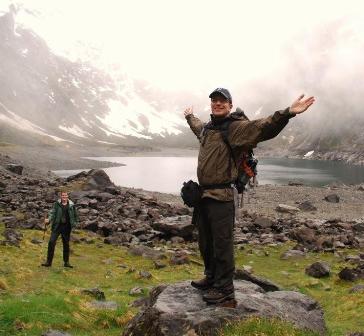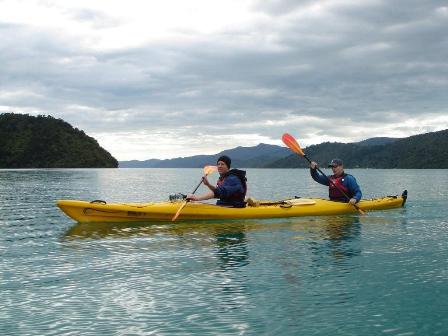
Mountain scenery: DWA is moved to song
The NZRA conference: spot the difference
In the midst of an peripatetic sabbatical, Duncan Wood-Allum reports from the New Zealand Recreation Association’s annual conference.

Mountain scenery: DWA is moved to song
What do you think of when it comes to conferences? Overly packed seminar programmes of mixed quality? Not enough breaks to network? Cheesed-off sponsors who’ve been hidden in the broom cupboard? Empty seats on the last day? I could go on but you will have your own personal gripes. Let’s face it. Historically, our conferences are predictable and about as inspiring as the World Darts Championship at Lakeside. There have been some encouraging signs of life in recent years from ISPAL and LIW but I was curious as to what our sector in other countries do so as part of my own world tour I managed to bag myself a speaking slot at the New Zealand Recreation Conference at Hawkes Bay in early November to tell, with the blessing of my dear friends at Warrington Borough Council, the Orford Park Story in the context of Olympic Legacy.
Brendon Ward, the chief executive of NZRA, gave me a clear steer when I met up with him in Wellington a couple of weeks before the event. When I asked him if he wanted to see my presentation, he coolly replied, “No mate – it’s your reputation.” The conference administration was slick and upon arrival at Napier Airport I was whisked off to my hotel and, after a quick change, driven to the mayoral function where I was introduced to the organising committee and some of the other keynote speakers. It was relaxed, casual and positive. The next day I arranged for my suit and shiny shoes to be sent back to England.
Day one of the conference was kicked off by Chris Tremain, a government finance minister standing in for Murray McCully, the minster of sport who apparently had a drama to deal with (something about Fiji). Chris rocked up in a cycling top promoting a cycle sportif in his region and clearly looked like a chap who took his fitness seriously. His 45-minute speech blew the audience away by highlighting innovation and best practice but he also reassured a nervous local government audience following recent rumblings about the sector being marginalised. It was clear that there was a debate at government level as to the value delivered by Kiwi Recreation and this was currently being reviewed. As someone enthusiastically whispered in my ear, “He actually gets what we do.” Too right, I agreed. I was trying to think of a UK MP who could actually fit into a cycling shirt.
Cycling Chris was then followed by an equally svelte Lawrence Yule, the mayor of Hastings, a man on a mission to deliver one major sports project in each of his three years in office. Lawrence clearly did not just get it but was driving it, namely a regional sports park worth 25 million quid that had some synergy with Orford Park in Warrington and number of sports parks in the UK.
A well-timed coffee break of thirty minutes followed and the conference floor was electric with everyone networking, laughing and enjoying their time together. Delegates then had a choice of two sets of three 45-minute concurrent sessions. Topics were varied, reflecting an audience of parks and recreation specialists and the programme was then followed by the final keynote speech that day, in which the CEO of the Tourist Association of New Zealand informed us that tourists spend 25 million quid a day in New Zealand. Adventure tourism plays a key role in the recreation sector in NZ and this was clearly something to shout about.
Lunch was superb and we then had a choice of two study tours or a bike ride along Napier’s beautiful coastline to visit a number of recreational projects. I saw three major facilities in three hours and was impressed at the level of information shared by the managers at each venue – a struggling water park, the new Hawkes Bay Sports Park and Petrigrew-Green Arena Development. At this point I was expecting to go back for a few beers with some diehards, scoff a dodgy curry, listen to people whinging over a whisky before bed. But no: we were bussed to the renowned Sileni Vineyard for a barbeque, a gathering that proved seriously sociable with a lot of local wine and fabulous food. All this was part of the 750 quid, three-day package. I thought ‘Kia Ora’ would have been a missed opportunity to show my growing respect to this proud bunch so at my request the Maori master of ceremonies, Marcus Akuhata-Brown (who is the best conference chair I’ve ever had the privilege to hear) spent an hour with me working on a traditional Maori opening greeting for my keynote. At this stage I knew about 50 delegates by their first name and at midnight the conference organisers tactfully escorted (some say ‘bundled’) me back to my hotel before I could enjoy the evening too much. Bleary-eyed, I started to make final preparations to practise my Maori.
On Tuesday morning my Maori intro went down well and the presentation was, according to my new Kiwi chums, very well received. The audience had been impressed by the achievements and ambitions of Warrington Borough Council and were keen to explore how they might be able to leverage benefits for the wider sector from the 2011 Rugby World Cup, as Warrington has from the 2012 Olympics. I was followed by Richard Beddle from Fitness New Zealand who delivered a very slick session on local government “being more commercial”. It is clear that the sector in New Zealand has historically enjoyed huge subsidies, with less than 10% cost recovery the norm for many facilities. A tea break and concurrent sessions followed. Lunch was a feast and by now I was really feeling part of the NZRA with lots of banter and business cards being exchanged. Was emigration becoming an option?
After lunch we heard from Deb Hurdle from Sport and Recreation New Zealand (SPARC, the NZ equivalent of Sport England) who focused on recent policy changes following the election of the new national government in 2008. Recreation had been added to SPARC’s portfolio. Deb looked like she could run a marathon with her eyes closed (I later found out she exercises two hours a day) and most of the delegates were fit, energetic and bright eyed. It seems that they really do walk the talk here.
Looking at the Kiwi sector in comparison to our own, it was clear the UK was ahead in a number of areas, including procurement, co-location of facilities, the cost-effectiveness of delivery and links with health. However, my new silver-ferned buddies had maintained their links with the parks sector and appeared to be doing a great deal of innovative stuff around participation with hard-to-reach groups. One excellent example of this is the award-winning 1,000 steps programme (www.10000stepsnorthland.co.nz). We clearly have a lot in common and huge amounts to share and learn from each other, something I am determined to champion from this point forward. Key shared issues include demonstrating outcomes, achieving value for money and targeting subsidy.
We then went off to sort out our costumes for the Art Deco fancy dress dinner and awards ceremony, which included a live broadcast of the Melbourne Cup. The awards clearly meant a lot to the NZRA delegates and winners were cheered loudly. It was good to see ISPAL doing a similar thing this July in the UK. The banquet-style dinner was a no speech zone, followed by a superb live band.
On the morning of the last day, I peeled my eyelids open and I was expecting single-figure turn out for the 9.30am start, a keynote in which Shelley Campbell, a Maori CEO of a heath authority, was exploring future opportunities and policy challenges in health. To my utter astonishment the auditorium was packed. Shelley, who is a Kiwi legend, blew us away. She covered topics such as new approaches to healthcare, what the sector could do to respond to the obesity epidemic and inspiring examples of innovation in community development, all delivered with a relaxed and personable style. She had been rubbing shoulders with ex-presidents at conferences across the world and it showed. This was one well-informed Maori lady and she was happy to share. My main ‘take away’ was the line, “Don’t tell, me – show me” in relation to evidencing impacts and outcomes.
Two more groups of excellent concurrent sessions kept things moving followed by lunch, which was a manic networking session. By now I would have thought folk would be sneeking out for an early exit to catch up on their sleep but the NZRA juggernaut was gathering even more momentum. The final two keynote sessions were from Nigel Cass, the general manager of the 2011 Rugby World Cup, who entertained us with inspirational videos and an informative session on progress – “96 Mondays to go”. Last but not least was a Kiwi adventurer, Jamie Fitzgerald, who rowed across the Atlantic and later walked to Antartica, avoiding (the editor of this fine journal will be pleased to observe) doing a ‘Cracknell.’ He was inspiring, funny and well briefed. My new best mate, Brendon Ward, wrapped things up beautifully and sent us all on our way with smiles on our faces and in eager anticipation of next year’s conference. As I said my farewells, he stuck a double CD of Kiwi dance anthems in my hand, just to make sure I had the words to singalong ‘down pat’.
Duncan Wood-Allum is director of t he Sport, Leisure and Culture Consultancy. Find him online at www.sportleisureculture.co.uk
The Leisure Review, December 2009
© Copyright of all material on this site is retained by The Leisure Review or the individual contributors where stated. Contact The Leisure Review for details.
Download a pdf version of this article for printing

DWA bringing up the rear on the way to work